“What does it mean to work with centers and the challenge of decentering the center, margins and borderlands, in-between spaces and marginalized peoples, languages, cultures, traditions?” These were some of the questions posed by Clemens Sedmak, professor of social ethics and director of the Nanovic Institute for European Studies, as he opened the conference “Reimagining Europe from Its Peripheries,” held at the University of Notre Dame on April 27-29, 2023. While the Nanovic Institute, part of the Keough School of Global Affairs, provided what Sedmak described as the “hardware” and logistical support for this conference, the “software,” the intellectual substance, was secured by three Notre Dame colleagues: Korey Garibaldi, assistant professor of American studies and Nanovic faculty fellow, Perin Gürel, associate professor of American studies and Nanovic faculty fellow, and Francisco Robles, assistant professor of English literature.
Over three days of presentations and discussions, this multidisciplinary meeting brought together scholars, policymakers, and practitioners from the U.S. and Europe. Their goal was to examine how political and cultural forces structure belonging in Europe, and to do so from the perspective of its shifting and precarious peripheries and peripheralized people. The conference theme reflected the Institute’s commitment, laid out in its strategic plan for 2021-2026, to encompass the lived experience of all people in Europe, including those marginalized by geography, poverty, policies of citizenship, and difference, in order to explore the humanity of those people and places Pope Francis has called “the peripheries” (Evangelii Gaudium 20).
A conversation on legal, social, and cultural peripheralization
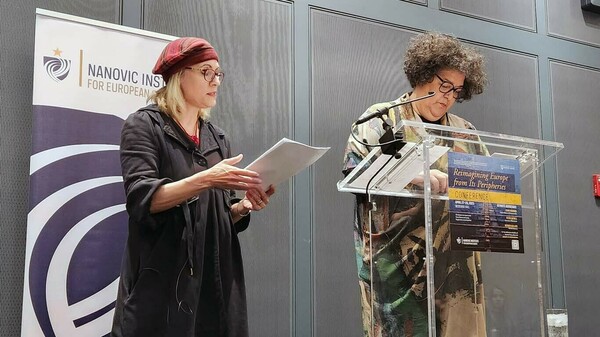
Three distinguished speakers delivered keynotes, beginning with an opening lecture by the French-Algerian author, art historian, and curator Zahia Rahmani, director of the Art History and Globalization Research Program at the National Institute for Art History in Paris. Rahmani delivered her lecture, titled “Building Europe Elsewhere: Restoring the World,” in French and was joined on stage by Alison Rice, professor of French and francophone studies at Notre Dame and Nanovic faculty fellow, who gave a live translation into English. By delivering her lecture on the ways in which European imperialists annexed and indexed “le monde, its objects, its plants, its rocks, and also its people” in French, Rahmani sent a powerful message about the hegemony of the English language in discussions of Europe and in academia in general.
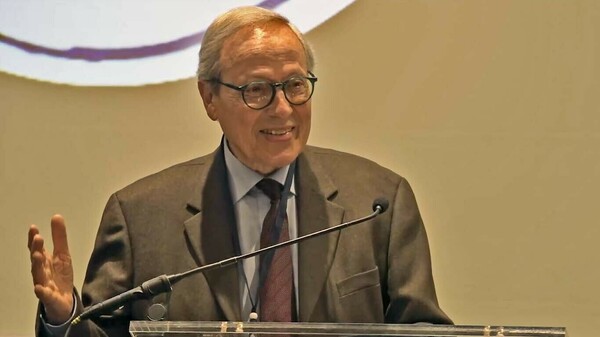
A second keynote lecture was delivered by Werner Sollors, the emeritus Henry B. and Anne M. Cabot Professor of English at Harvard University, who spoke on the popularity of German writer Johann Wolfgang von Goethe (1749-1832) with Black American authors, poets, singers, and others since the late 19th century. Sollors has found Goethe to be ubiquitous in Black American cultural outputs in this period, such that his research allows for an examination of one of Germany’s most celebrated writers “from without, from the periphery.”
“The world isn't given. It requires effort. Your effort and my effort, and indeed, the efforts of scholars.”
Peter Gatrell
The conference’s final keynote was delivered by Peter Gatrell, professor of migration and economic history at the University of Manchester, and was titled “The Unsettling of Europe—further reflections on migration in/to Europe since 1945.” The lecture drew in part from Gatrell’s book The Unsettling of Europe: How Migration Reshaped a Continent (Basic Books, 2019) which was awarded the 2021 Laura Shannon Prize in Contemporary European Studies by the Nanovic Institute. His research, Gatrell explained, shows how “hitherto marginal or neglected sites in European history become salient because of migration.” After covering a range of topics related to belonging, migration, and peripheralization of various communities, Gatrell ended his address on a note of hope and with a challenge: “The world isn't given. It requires effort. Your effort and my effort, and indeed, the efforts of scholars.”
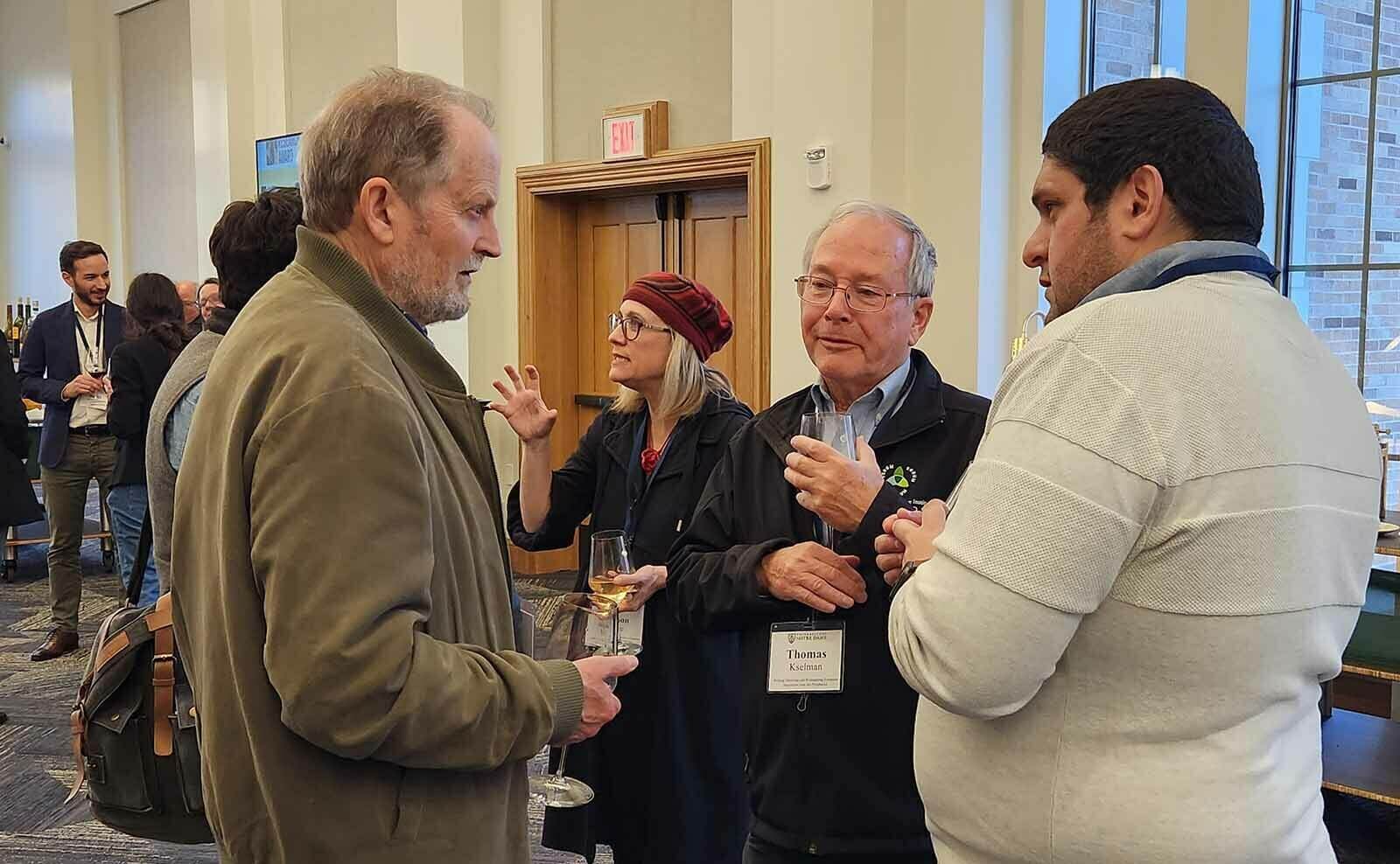
Interspersed with the keynotes were four sessions that focused on:
- The ways in which humans are marginalized through the legal framing of migration across Europe’s sea borders and airways;
- The legal, cultural, and social contracts that cast citizenship and inclusion in Europe through the lens of race;
- The experience and legacies of slavery and borderization in European empires; and
- The exploration of uncollected memories of peripheralized voices in Europe, such as the Roma and the Gay Pride movement, through the arts and protest culture.
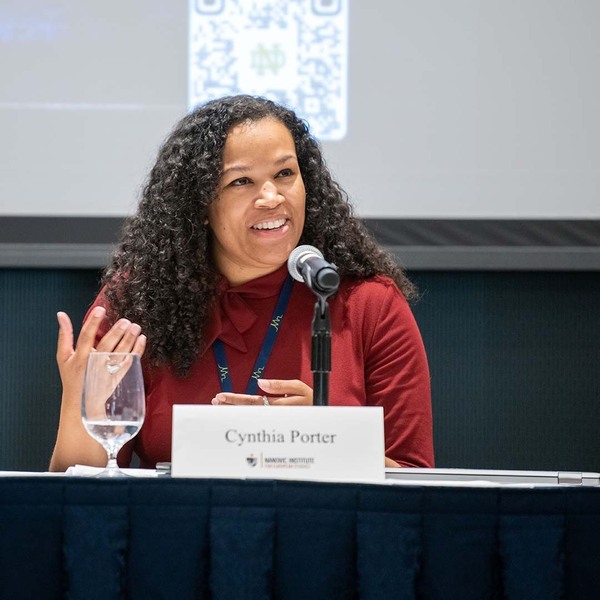
Some highlights included a presentation by Tommaso Manfredini, a lecturer in French and romance philology at Columbia University, in which he traced the legal evolution of the word clandestine from an adverb (passage clandestin(e), the act of stowing away) to a noun (clandestin(e), an individual whose unauthorized presence makes them illegal). This codification in law, Manfredini argued, illegalized certain types of migration, typically from former French colonies on the African continent, in the Francophone Mediterranean. In her presentation on German policing and the #BlackLivesMatter movement, Cynthia Porter, assistant professor in the department of German languages and literatures at the Ohio State University looked at filmic evidence in connection with law enforcement and how structures of law and justice get broken down in films. During the final panel of the conference, Daniel Makonnen presented his research for the European Commission on the competing narratives around the Roma people in Europe. These are just three examples from a rich and engaging schedule of presentations.
As part of the conference program, participants also attended a screening of the Ukrainian film Klondike (2022), which tells the story of expectant parents Irka and Tolik, residents of the Donetsk region of eastern Ukraine near the Russian border, which was disputed territory in the early days of the Donbas war. After their village witnesses the crash of Malaysian Airways Flight 17, the couple confronts tensions within their family and community. The film’s writer and director, Maryna Er Gorbach, attended the screening virtually to lead a robust discussion with the audience following the film.
“Widening and deepening the imagination”
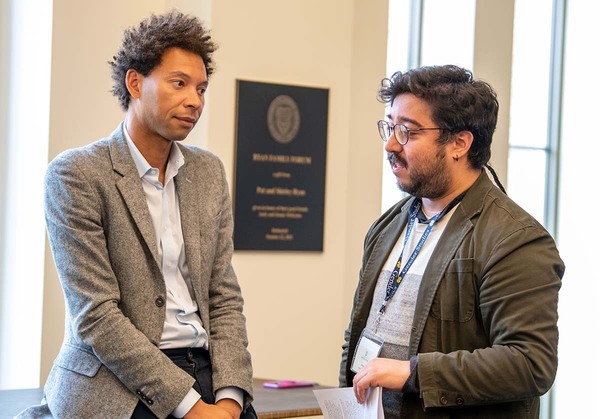
For the conference organizers, the meeting stimulated new ways of thinking about peripheries and peripheralization in Europe and sparked ideas for future conversations and collaborations. Garibaldi says, “Our visitors were immensely stimulated by the Nanovic Institute’s signature conference and are looking forward to continuing conversations prompted by numerous thematic continuities between panels and keynote lectures.” Commenting on the interdisciplinary nature of the conference, he adds, “Indeed, it has been remarkably generative to put scholars in dialogue with one another who work in a broad range of fields related to European Studies.”
Reflecting on the conference, Sedmak offers the following thoughts:
“The imagination is the sense of what is possible and the sense of alternatives to the status quo. The very idea of challenging established ways of imagining Europe through perspectives representing an alternative to ‘textbook views’ of Europe was refreshing and stimulating. The bilingual opening with its performance of redefining the center was powerful. The contested concept of ‘peripheries’ emerged for me as a powerful hermeneutical tool. Looking at Europe through the lens of Roma, Afro-Europeans, and refugees is as powerful as the idea of looking at the reception of European culture in black America or as the idea of rewriting the history of Europe from an Ottoman perspective. This exercise in widening and deepening the imagination renegotiates the boundaries of ‘the mainstream’ and challenges the dynamics of what can be taken for granted. I appreciated the moral motivation behind these intellectual efforts to promote a more inclusive and more just world and way of thinking, very much in line with integral human development, an approach that is at the heart of the Keough School’s mission.”
The organizers expressed their gratitude to those who made the event possible. “The extraordinary scope and success of this conference,” Garibaldi says, “would have been impossible without Clemens Sedmak’s enthusiasm, and months of expert planning and coordination facilitated by Rebekah Prince, Melanie Webb, and Grant Osborn.” In turn, the Nanovic Institute is grateful to Garibaldi, Gürel, and Robles for their leadership and vision, to those who made additional intellectual contributions (including Rice, Tetyana Shlikhar, assistant teaching professor of German and Russian languages and literatures, and Chanté Mouton Kinyon, assistant professor of English), and to the keynotes and participants who generously brought their perspectives and insights to bear on a remarkable conversation about the margins and the marginalized in Europe, past and present.
The brief video above gives a broad overview of the conference, focusing on the keynote sessions.